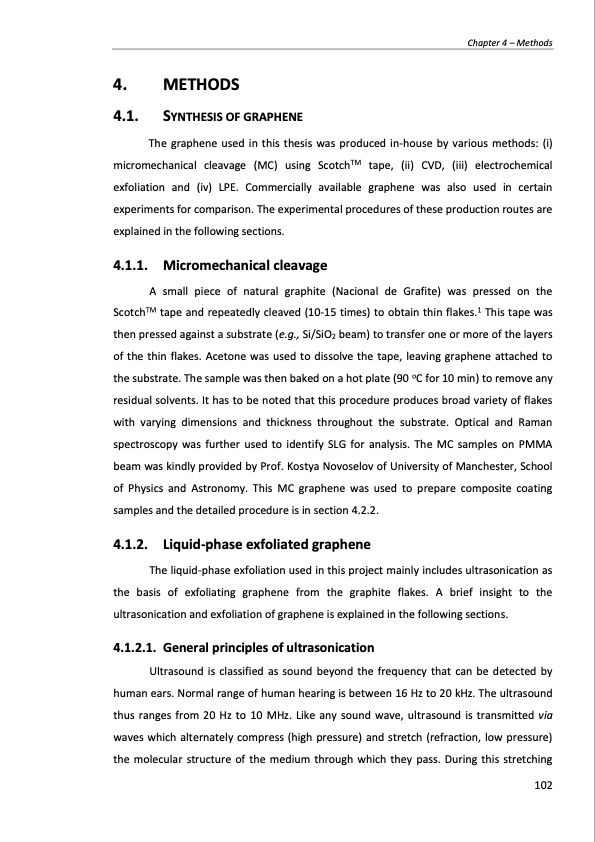
PDF Publication Title:
Text from PDF Page: 102
4. METHODS 4.1. SYNTHESIS OF GRAPHENE The graphene used in this thesis was produced in-house by various methods: (i) micromechanical cleavage (MC) using ScotchTM tape, (ii) CVD, (iii) electrochemical exfoliation and (iv) LPE. Commercially available graphene was also used in certain experiments for comparison. The experimental procedures of these production routes are explained in the following sections. 4.1.1. Micromechanical cleavage A small piece of natural graphite (Nacional de Grafite) was pressed on the ScotchTM tape and repeatedly cleaved (10-15 times) to obtain thin flakes.1 This tape was then pressed against a substrate (e.g., Si/SiO2 beam) to transfer one or more of the layers of the thin flakes. Acetone was used to dissolve the tape, leaving graphene attached to the substrate. The sample was then baked on a hot plate (90 oC for 10 min) to remove any residual solvents. It has to be noted that this procedure produces broad variety of flakes with varying dimensions and thickness throughout the substrate. Optical and Raman spectroscopy was further used to identify SLG for analysis. The MC samples on PMMA beam was kindly provided by Prof. Kostya Novoselov of University of Manchester, School of Physics and Astronomy. This MC graphene was used to prepare composite coating samples and the detailed procedure is in section 4.2.2. 4.1.2. Liquid-phase exfoliated graphene The liquid-phase exfoliation used in this project mainly includes ultrasonication as the basis of exfoliating graphene from the graphite flakes. A brief insight to the ultrasonication and exfoliation of graphene is explained in the following sections. 4.1.2.1. General principles of ultrasonication Ultrasound is classified as sound beyond the frequency that can be detected by human ears. Normal range of human hearing is between 16 Hz to 20 kHz. The ultrasound thus ranges from 20 Hz to 10 MHz. Like any sound wave, ultrasound is transmitted via waves which alternately compress (high pressure) and stretch (refraction, low pressure) the molecular structure of the medium through which they pass. During this stretching Chapter 4 – Methods 102PDF Image | PRODUCTION AND APPLICATIONS OF GRAPHENE AND ITS COMPOSITES

PDF Search Title:
PRODUCTION AND APPLICATIONS OF GRAPHENE AND ITS COMPOSITESOriginal File Name Searched:
graphene-production-applications.PDFDIY PDF Search: Google It | Yahoo | Bing
Salgenx Redox Flow Battery Technology: Power up your energy storage game with Salgenx Salt Water Battery. With its advanced technology, the flow battery provides reliable, scalable, and sustainable energy storage for utility-scale projects. Upgrade to a Salgenx flow battery today and take control of your energy future.
| CONTACT TEL: 608-238-6001 Email: greg@infinityturbine.com | RSS | AMP |